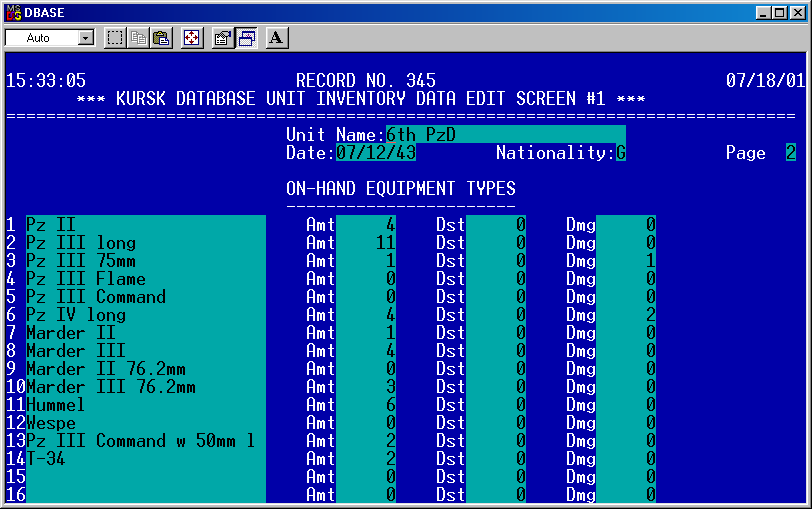
Just to state the obvious, Prokhorovka was not just a tank battle. While the Soviets attacked without proper air or artillery support, the Germans did have that. The Germans had a lot of antitank weapons they could bring to bear. Let us look at the inventory on the evening of the 11th for the LSSAH Division (this listing does not include small arms):
MMG: 136
28/20 AT: 0
50mm AT: 35
75mm AT: 16
81mm Mortar: 67
75mm lt IG: 15
150mm hy IG: 0
105mm Howitzer: 15
150mm Howitzer: 12
105mm Gun: 4
150mm Launcher: 6
210mm Launcher: 6
20mm AA (towed): 26
20mm AA (SP): 24
20mm AA x 4 (SP): 11
37mm AA (SP): 10
88mm AA: 10
.
Pz I: 2
Pz II: 4
Pz III short: 1
Pz III long: 4
Pz III Observation: 8
Pz III Command: 7 (most were armed)
Pz IV Long: 47
Pz VI: 4
StuG III: 10
Marder III: 10
Hummel: 5
Wespe: 12
Grille: 12
Marder II 76.2mm: 1
Pz IV Munitions: 1
.
AC 4w MG (221): 4
AC 4w 20mm (222): 7
AC 4w MG (223): 5
AC 8w 20mm (231): 1
AC 8w 20mm (232): 4
AC 4w (261): 10
AC 8w MG (263): 0
AC 4w (247): 1
.
LHT (2501/1): 25
LHT (250/3): 22
LHT 81mm Mortar (250/7): 4
LHT 37mm AT (250/10): 3
LHT 20mm (250): 8
MHT (251/1): 26
MHT 81mm Mortar (251/2): 4
MHT (251/5): 1
MHT (251/7): 9
MHT (251/6): 1
MHT (251/8): 4
MHT 75mm Lt IG (251/9): 4
MHT 37mm AT (251/10): 7
LHT (252): 4
LHT (250/5): 6
LHT (253): 4
MHT (251): 5
LHT (250/4): 3
.
Bridge Set J: 1
Bridge Set H: 1
.
Source: Kursk Data Base, TDI copy.
So, they had:
Antitank guns (including 37mm AT) and 88mm Flak: 71
Tanks 50mm and greater (including Marders): 84
Artillery pieces and rockets (105mmm or larger): 72
Miscellaneous stuff that goes boom (37mm AA, 75mm lt IG, 81mm Mortars): 104
.
Now that is over 200 serious tank killing weapons not counting the “miscellaneous stuff.” If one is in a defensive position facing an attack coming across open ground, there is a lot of damage that can be done.
Oh and they also had air support. Now we really don’t know how much air support they had. It was reported that at 0910 (Berlin time), the VIII Air Corps notified the SS that it had dispatched two Stuka groups. The Germans flew 398 ground-attack type sorties this day of which 150 were Stuka sorties. As they were supporting five German corps, not all of these missions went to the SS Panzer Corps. In my engagements sheets (pages 954-959 of Kursk and 345-352 of Prokhorovka), I have the T SS PzGrD with 94 supporting sorties, the LSSAH PzGrD with 131 supporting sorties + 24 Soviet fratricidal sorties, the DR SS PzGrD with 57 supporting sorties and the 167th Infantry Division with 92. Of course, these are very rough guesstimates.
They also had some support from “friendly fire” cases where at 1300 Soviet assault aircraft (Il-2s) attacked the 32nd Tank Brigade (XXIX Tank Corps) and 170th Tank Brigade (XVIII Tank Corps). The II Guards Tank Corps was also attacked by Soviet aircraft (see Prokhorovka, page 338).
The Totenkopf and Das Reich SS Divisions were similarly equipped. So, there were a lot of weapons there.

>>>50mm AT: 35; 75mm AT: 16
The effectiveness of the TD is about three times higher than towed artillery. The antiaircraft artillery had enough of its affairs, Soviet aviation tried to influence the battlefield.
We must look at the disposition of the destroyed Soviet tanks. These are the documents of the Trophy Department and repairmen (annexes to the act of technical examination).
Knowing the position of the German tanks and infantry (towed artillery), it will be possible to approximately represent who and whose victim in 70% of cases.
You have Pz III long listed twice: quantities 4 and 47 . Is the second one a Pz IV long?
Thanks. Corrected. Typo. I did have to re-type the list from the data base. I am not the greatest tpyist.
2nd SS Panzerkorps consumption of munitions for the 12th was:
5cm PzGr.39 Pak, 720
5cm HE 38 Pak, 537
5cm HE KwK 39, 913
5cm PzGr. 39 KwK, 692
7.5cm HE Pak 40, 155
7.5 cm PzGr. 39, 375
7.5cm GrPatr. HL/A/B, 78
7.5 cm HE KwK 40, 5460
7.5 cm PzGr.39 KwK, 3480
7.5cm GrPatr. HL/B, 1135
21cm Mrs 18, 170
10cm Gr.19, 1387
Based on the lethality index of the involved weapon systems, the majority of hard targets must have been destroyed by 75mm fire. Almost 3/4th of all AT projectiles consumed on the 12th, were fired out of a KwK 40. Panzerjäger units were schooled in artilleristic fashion, so they would require less ammo on average to knock out a vehicle.
This contradicts the theory that the German formations were well prepared (Zamulin), awaiting a Soviet attack. In fact, they were resting (diary), so the area may have not been pre-sighted and only few stationary AT systems might have been zeroed in.
We could estimate that approx. 50-60 T-34s were destroyed (and 40-50 additionally damaged) by Panzer IVs and Jägers. That is at least: One damaged and destroyed for each crew, if they are distributed (but I expect multimodality).
Aircraft is relevant for recon and possesses a disruptive and suppressive effect, but they were not responsible for inflicting a lot of armour losses.
Multiple questions have been raised regarding the composition (inventory/armament) of SS and Wehrmacht divisions. There does not seem to be any pronounced difference, or where they prioritized? One problem here is of course that we do not know if they received an improved or better variant (selection) of the same type.